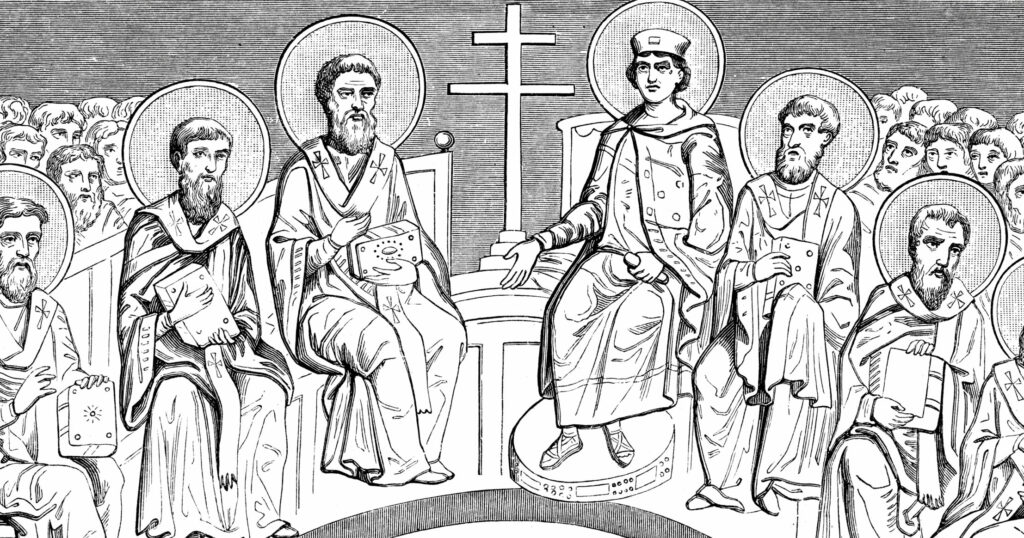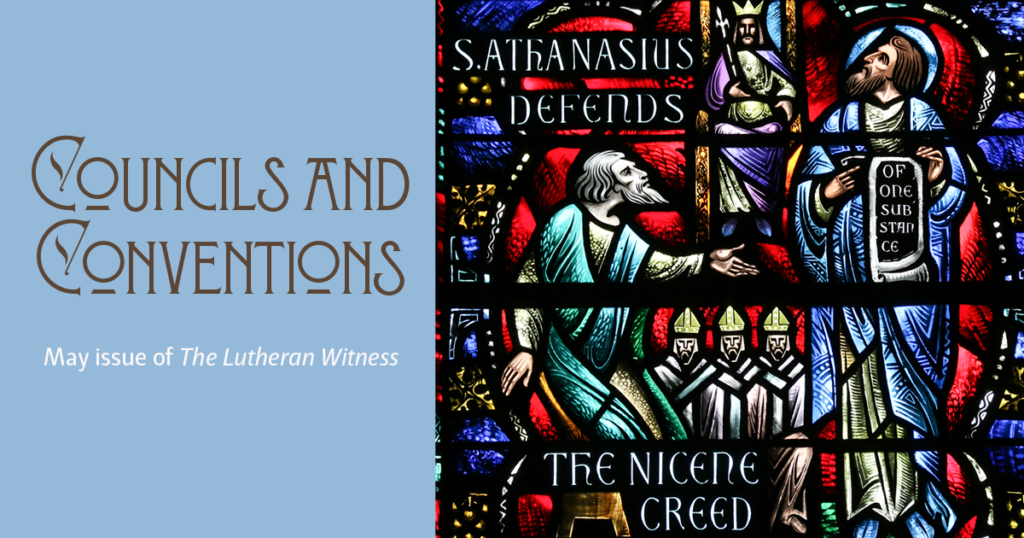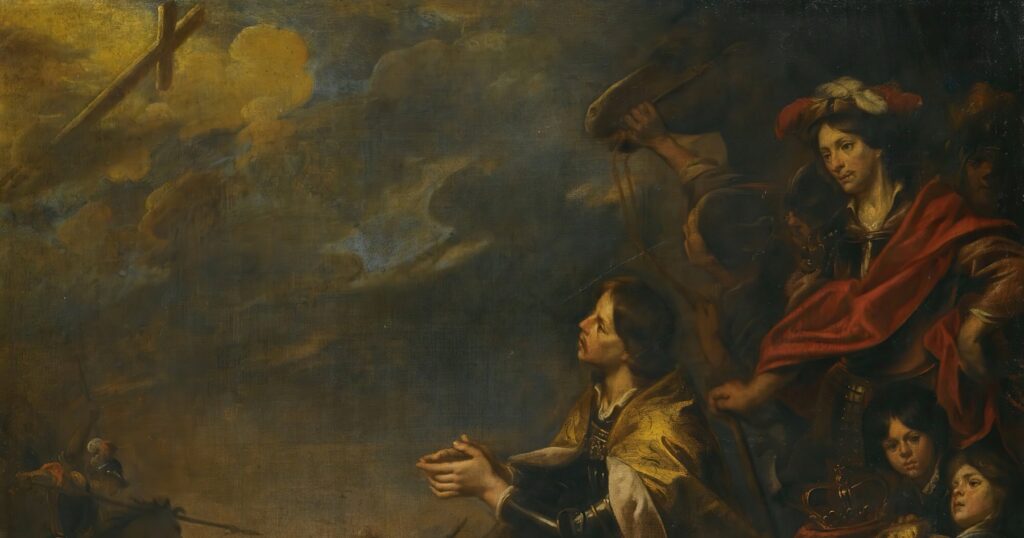By Joel Elowsky
1,700 years ago, there was a newly united Roman Empire headed by a young emperor from Serbia named Constantine. The horrific persecution of Christians under Diocletian (A.D. 303–313) had just ended, and decrees pronouncing toleration of Christians had been issued by Galerius in 311 and by Constantine I and Licinius with the Edict of Milan in 313. In 312, Constantine had made his famous defeat of Maxentius at the Milvian Bridge: During the battle, “he saw with his own eyes the trophy of a cross of light in the heavens, above the sun, and an inscription, CONQUER BY THIS, attached to it.”[1] Later that night, Constantine had a dream where Christ told him to mark this cross on the shields of his soldiers.[2] Was this a sign of a new age, with a new emperor favorable to Christianity?
The debate over Constantine’s actual conversion continues among scholars. I see no problem with the account as written and believe it is authentic. Yet whether the emperor’s conversion was sincere or not, something had changed in the empire — and Roman emperors knew the power of faith in the public sphere. By the early fourth century, even before Constantine ascended the throne, Christianity had already grown into a force to be reckoned with. But with the growth also came tension and division. It was important to keep the empire united not only politically but also in matters of faith.
Divisions in the Church
The Diocletian persecution had put Christianity to the test. Divisions had developed in the church over what to do with those who had denied the faith under threat of torture or death. During the persecutions, while Bishop Peter of Alexandria languished in prison, Bishop Meletius of Lycopolis in Egypt began ordaining bishops. Meletius was part of the rigorist camp who thought the church was too lax in its requirements for readmission. He thought those he ordained could help right the ship of the church and bring it back to a purer form.
Another division in the church had deeper roots. It dated back at least to the second century and concerned when to celebrate Easter. Churches in Asia Minor and Syria followed the Jewish calendar, celebrating Easter on the 14th day of Nisan, the day when the Jews celebrated Passover. It could occur any day of the week. These Christians celebrated Easter on this date because the events of the Passion and resurrection recorded in the Gospels took place around the time of the Jewish Passover. Churches in Rome, Alexandria and Palestine, on the other hand, celebrated Easter on whatever Sunday followed the Jewish celebration of the Passover. They insisted that Easter always be celebrated on a Sunday, the day of the week when Christ rose from the dead. It was an important question for the church because pagans, like Porphyry and the second-century philosopher Celsus, had ridiculed the church for not being able to agree on the celebration of one of its most important commemorations.
While these issues were important, trouble was also brewing on another front that would occasion the calling of the Council of Nicaea. An upstart presbyter in the Alexandrian suburb of Baucalis named Arius had charged his bishop, Alexander, with false doctrine.[3] The historian Socrates reports that Alexander had embarked on too ambitious a theological discussion of the unity of the Trinity in front of his presbyters and the rest of the clergy.[4] Arius publicly challenged him, asserting that Alexander was espousing the heresy of modalism, ignoring the distinctions of the persons in the godhead.
Arius was concerned that the distinction between the Father and the Son was not being maintained. There could be only one creator and originator of all things: God the Father, who had no beginning. Arius challenged Alexander with a logical syllogism:[5] “If the Father had begotten the Son, the one begotten had a beginning to his existence; from this clearly one must conclude that there was a time when the Son did not exist. It then follows necessarily that his substance arose out of nothing.”[6] Arius believed that the Son was a creature — different from the rest of creation, but a creature nonetheless — whom God created to bring the rest of creation, including us, into being.
Over the next five years, the controversy escalated. In the meantime, Constantine became sole emperor in 324, defeating Licinius, his rival in the east who had been persecuting Christians. With this new and hard-fought political unity, Constantine was concerned about the theological dispute taking place in Alexandria. Thinking all of this was simply an argument over words that could be solved through negotiation, he sent his representative Bishop Hosius of Cordoba to Alexandria to try and resolve the matter. Hosius was not successful. Constantine decided to try something that had never been done on the scale he was envisioning. He wanted to call a church council that would include all the bishops of the empire.
The Great Council and the Nicene Creed
The historian Eusebius notes there was some urgency to hold the council: “All hurried eagerly to Nicaea as if competing in a race,” hoping for peace to be restored quickly to the church and the empire, and also eager for a chance to see this emperor who was so favorable toward the church.[7] Somewhere between 250 and 318 bishops attended. These bishops were accompanied by acolytes, deacons, presbyters and others too many to count — perhaps as many as 2,000 — from “Europe, Africa and Asia.”[8] There were also many laymen who were skilled in the art of philosophy and debate, each “eager to advocate the cause of his own party.”[9] Priests and people were invested in this theological debate. It garnered as much attention as the Super Bowl or March Madness does today.
The council was convened sometime around May 20, 325, for preliminary discussions. It most likely officially opened around June 19 or 20. Bishops were seated according to rank and lined the palace hall on both sides, having the decisive vote (votum decisivum) in all matters of church discipline and theology. Constantine entered last, preceded by friends and members of his family, but no military entourage. He addressed the assembly, expressing his deep concern over the division in the church, and implored the bishops to find peace, just as he had brought peace to the land. Just like in the Roman senate, he had no vote. But according to Eusebius, he most likely participated in debate. And there was plenty of debate before the council and during the proceedings.
The key issue of the debates concerned Arius and his insistence that the Son was a creature of the Father, albeit highly exalted. The chief point of contention was the term homoousios (the Son being “of the same essence” with the Father). The Arians rejected this term, believing that it parceled out God’s essence into different entities so that God was no longer one. Further, they argued, since the Son had become incarnate and suffered, this meant He was subject to change; therefore, He could not be God. The orthodox countered that homoousios was the only term that could speak to the unity and equality of the Son with the Father. The Son is “not only like, but also inseparable from the essence of the Father. He and the Father are one [John 10:30].”[10] God took on flesh and suffered in order to change our nature, not His.
After many days of debate, they settled on the wording of the Nicene Creed, utilizing many of the same phrases that had appeared in a creed earlier that year at a council held in Antioch. They sent it to Constantine, noting that there were 18 or so detractors among the Arians. Most of these promptly signed after Constantine threatened them with exile. Arius was exiled, along with a couple of other bishops, and his writings were ordered to be burned (which is why we have to rely on his opponents for most of what we know about his teaching).
We assume the council lasted until July 25, with most bishops staying around to observe the celebration of Constantine’s 20th anniversary as emperor. At the conclusion of the council, the creed was adopted, with threats of banishment for those who disagreed. The council also decided that Easter would be observed on the first Sunday after the vernal equinox. In order to resolve the Meletian schism, the bishops resolved to recognize the ordinations Meletius had performed, although the clergy would be of secondary rank in the churches of their diocese. They also insisted that Meletius not ordain any new clergy. There were 20 disciplinary canons issued as well, concerning clergy misconduct, church discipline for those who had lapsed during the Diocletian persecution, church structure and oversight, the readmission of heretics and schismatics, and liturgical matters. A letter detailing the decisions of the council was sent to Egypt and presumably the rest of the churches. Constantine held a closing banquet and sent the bishops home with parting gifts according to rank, guaranteeing them safe passage home.
Constantine and the bishops had achieved their desired unity through a combination of persuasion and force. The peace was short lived, however, as often happens when there is a forced consensus. Within a decade or so, Arius had been welcomed back, Constantine was baptized on his deathbed by his Arian bishop, and a new era of disunity ensued with Arian emperors and their bishops enforcing a pro-Arian interpretation of Nicaea over the next 50 years. Athanasius faced five exiles for his staunch defense of Nicaea. A second ecumenical council was called by emperor Theodosius I at Constantinople in 381 to resolve the divisions and expand the third article of the creed to take up the subject of the Holy Spirit, where a similar fight occurred over His divinity.
[1] Eusebius, Life of Constantine, 1.26–29.
[2] Lactantius, On the Death of the Persecutors, 44.3–6.
[3] Theodoret, HE 1.2.
[4] Socrates, HE 1.5.1b.
[5] Both church historians Socrates and Sozomen accuse Arius of being a logician more than a theologian, asserting that this ultimately led him into heresy.
[6] Socrates, HE 1.5.2.
[7] Eusebius, HE 3.6b.
[8] Eusebius, HE 3.7a.
[9] Sozomen, HE 1.8.13.
[10] Athanasius, De Decretis, 20.

This article originally appeared in the May 2025 issue of The Lutheran Witness.





First the vernal equinox. Then a full moon. Then a Sunday. That is how the date of Easter is set.
Thank you, Dr. Elowsky, for your article.